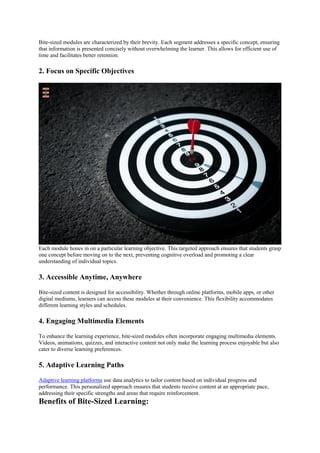Measuring the Impact of Bite-Sized Learning: Proven Strategies for Prosperous Results
Bite-sized learning—also known as microlearning—has revolutionized the way we acquire skills and knowledge in today’s fast-paced world. As organizations and educators evolve their approaches, measuring the impact of bite-sized learning modules becomes essential too ensure successful results, maximize engagement, and achieve learning objectives. In this article, we’ll dive deep into proven strategies for quantifying the effectiveness of microlearning, share practical tips, and showcase real-life examples that highlight best practices.
What is Bite-Sized Learning?
Bite-sized learning refers to breaking down complex training topics into short, easily digestible segments—typically lasting between 3 to 7 minutes. This method aligns with how modern learners prefer to access information: quickly, on-the-go, and in manageable chunks. common forms include micro-videos, interactive quizzes, infographics, podcasts, and concise readings.
- Boosts knowledge retention and recall
- Improves learner engagement and motivation
- Enables just-in-time learning for specific tasks or challenges
- Provides flexibility for self-paced learning
- Scales efficiently across diverse teams and locations
Why Measuring the Impact of Bite-Sized Learning Matters
Implementing microlearning is onyl the first step; tracking its effectiveness is crucial for continuous improvement and ROI. Measuring the impact of bite-sized learning allows organizations and educators to:
- Identify strengths and areas for advancement in content
- Understand learner progress and performance
- Ensure alignment with business or academic goals
- Demonstrate clear value to stakeholders
- Drive data-informed decisions for future learning strategies
Key Metrics for Assessing Bite-Sized Learning Success
To accurately measure the impact of microlearning, consider both quantitative and qualitative metrics:
Quantitative Metrics
- Completion Rates: Track how many learners complete each module or activity.
- Engagement Statistics: monitor time spent, click-through rates, repetition, and interaction levels.
- Assessment Scores: Analyze quiz/test outcomes before and after modules.
- Knowledge retention: Use follow-up assessments weeks or months later to evaluate long-term retention.
- Performance Improvements: Measure workplace or academic performance pre- and post-training.
Qualitative Metrics
- Learner Feedback: Collect surveys, reviews, and testimonials about learning experiences.
- Manager/Supervisor Observations: Gain insights on observable behavioral changes or skills application.
- Discussion Participation: Gauge involvement and thoughtfulness in forums or group discussions.
Proven Strategies for measuring Microlearning Impact
Below are actionable strategies to effectively measure the results of your bite-sized learning initiatives:
1. Leverage Learning Analytics Platforms
modern learning Management Systems (LMS) and analytics tools allow real-time tracking and robust reporting. Choose platforms that offer:
- Dashboards for monitoring module completion and engagement
- Customizable reports to focus on your KPIs
- Integration with other business performance systems
2. Implement Pre- and Post-Assessments
Use short assessments before and after each microlearning module to measure knowledge acquisition and skills development. This provides clear data on learning gains attributable to each bite-sized lesson.
3. Incorporate Scenario-Based Evaluations
Present learners with real-life scenarios or decision-making tasks related to their roles. Evaluate accuracy, decision speed, and confidence levels as indicators of learning transfer and application.
4. Track Longitudinal Outcomes
Don’t stop at immediate results. Schedule follow-up assessments or surveys weeks after training to measure how well learners retain information and integrate new skills into their workflow or studies.
5. Gather Continuous Feedback
Routinely solicit learner input on content relevance,usability,and impact.Use this to refine future microlearning modules and ensure alignment with evolving needs.
6. Benchmark against organizational KPIs
Link bite-sized learning outcomes to tangible business or academic goals such as increased productivity,higher sales,fewer errors,or enhanced customer satisfaction. Demonstrating a clear line between learning and organizational performance is key for stakeholder buy-in.
Case Study: Bite-Sized Learning Delivering Real Results
TechStart: Increasing Sales Efficiency Through Microlearning
A technology startup, TechStart, struggled with lengthy in-person sales training that often disrupted work and failed to keep reps engaged. They introduced a microlearning solution with daily 5-minute modules and weekly micro-quizzes. Over six months, the results were clear:
- Completion rates jumped from 65% (customary) to 94% (bite-sized).
- Knowledge retention scores improved by 30% in post-training assessments.
- Sales figures rose by 18% quarter-over-quarter, correlating with timely learning and reinforcement.
- Feedback: 87% of reps preferred the new bite-sized format, citing increased motivation and better work-life balance.
TechStart’s experience demonstrates how measuring the impact of bite-sized learning can lead to both improved business outcomes and higher learner satisfaction.
Practical Tips for Maximizing the Impact of Bite-Sized learning
- Align microlearning objectives with overarching business or educational goals.
- Design content for mobile-first access so learners can engage anytime,anywhere.
- Use spaced repetition to reinforce key concepts and boost retention.
- Keep modules focused on a single learning objective to minimize cognitive overload.
- Encourage active participation through polls, quizzes, and real-life scenarios.
- Visualize progress with badges, progress bars, or leaderboards to drive learner motivation.
- Measure, analyze, and iterate—continuously refine your approach based on feedback and outcome data.
First-Hand Experience: Voices from the Field
Learners consistently report that microlearning fits seamlessly into their busy schedules and helps them retain information better than traditional, lengthy courses. Here’s what some have said:
“I can squeeze in a quick 5-minute lesson on my commute. It’s a game-changer for my professional growth.” — Marketing Associate
“The short quizzes keep me on my toes and boost my confidence at work.” — Customer Support Specialist
“Bite-sized learning makes it easier for my team to stay current without overwhelming them.” — HR Manager
Conclusion: Unlock the Full Potential of Bite-Sized Learning
Measuring the impact of bite-sized learning is essential for maximizing its advantages in any educational or organizational setting. By leveraging data-driven strategies, actionable metrics, ongoing feedback, and continuous alignment with core objectives, you ensure that your microlearning initiatives don’t just reach learners—they resonate, engage, and drive real, measurable success.
Ready to harness the power of bite-sized learning? Start today by setting clear goals, using robust measurement tools, and applying the proven strategies outlined above. With the right approach, microlearning can elevate your institution’s performance and empower learners to reach their full potential.

